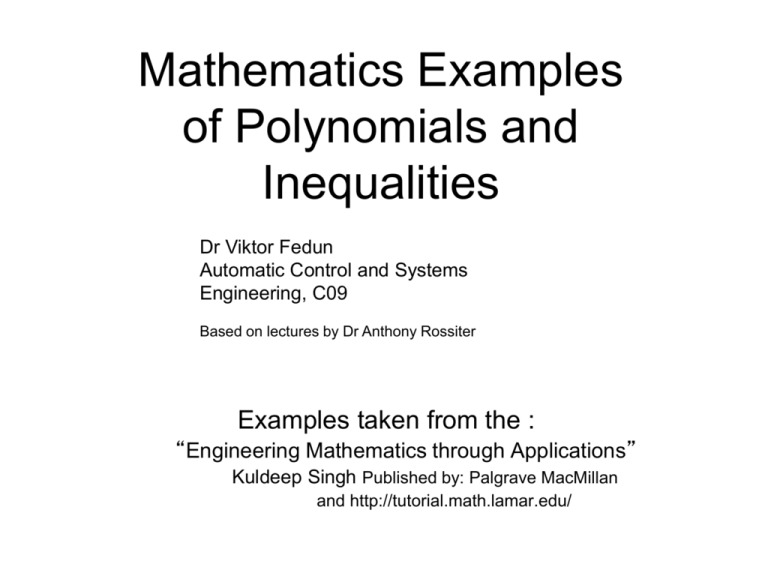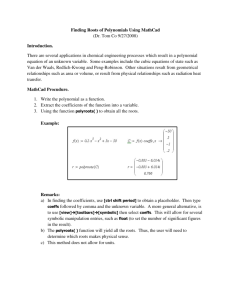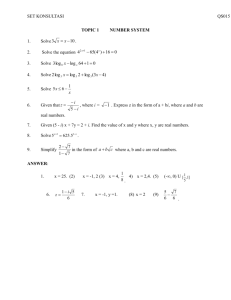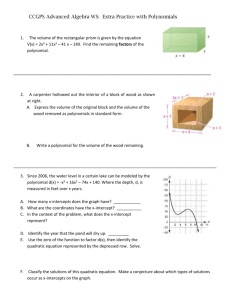Mathematics Examples of Polynomials and Inequalities
advertisement

Mathematics Examples of Polynomials and Inequalities Dr Viktor Fedun Automatic Control and Systems Engineering, C09 Based on lectures by Dr Anthony Rossiter Examples taken from the : “Engineering Mathematics through Applications” Kuldeep Singh Published by: Palgrave MacMillan and http://tutorial.math.lamar.edu/ Example 1 (Page 145 Example 11) [Mechanics] The displacement, x(t), of a particle is given by: x(t)= (t-3)2 (a) Sketch the graph of displacement versus time (b) At what time(s) is x(t)=0? Example 1 Solution Solution: (a) It is the same graph as the quadratic graph t2 but shifted to the right by 3 units. (b) x(t)=0 when t=3 Example 1 x(t) 0 Solution x(t)= (t)2 3 x(t)= (t-3)2 t Example 2 (Page 113 Exercise2 (c) q2 [Fluid Mechanics] The velocity, v, of a fluid through a pipe is given by: v = x2 – 9 Sketch the graph of v against x. Example 2 Solution v(x) v(x)= x2 v(x)= x2-9 -3 3 0 -9 x Example 3 (Page 118 Exercise 2(d) q3) [Electrical principles] The voltage, V, of a circuit is defined as: V = t2 – 5t + 6 (t ≥ 0) Sketch the graph of V against t, indicating the minimum value of V Example 3 Solution In order to plot the graph, it helps to find the values of t for which the graph cuts the t axis, and the value of V for which the graph crosses the V axis. For the t axis, factorising the polynomial function and then setting equal to zero will tell us of those values where the graph crosses the t axis (i.e. when v=0). V = t2 – 5t + 6 (t ≥ 0) =(t-2)(t-3) So either (t-2)=0 or (t-3)=0 giving the crossings at t=2 and t=3 For the V axis, the graph crosses the V axis when t=0, giving V(t=0)=6 Example 3 Solution v(t) v(t)= t2-5t+6 6 0 Note: t ≥ 0 2 3 t The minimum value is here Polynomials Functions made up of positive integer powers of a variable, for instance: y x2 2 g p 2p 5 q s 2s 3 3 2 v w 2w w 5 z 4 ( yes even this) Degree of a polynomial The degree is the highest non-zero power Degree of 1 Degree of 2 Degree of 5 Degree of 3 Degree of 0 y x2 2 g p 2p 5 q s 5 2s 3 3 2 v w 2w w z 4 ( yes even this) Typical names Degree of 0 Degree of 1 Degree of 2 Degree of 3 Degree of 4 Etc. constant linear quadratic cubic quartic Multiplying polynomials If you multiply a rth order by an mth order, the result has order r+m. ( x a)(cx b) cx 2 acx bx ab (ax 2 bx c)( dx 3 x e) adx 5 bdx 4 (cd a) x 3 (ae b) x 2 ( x a)( x a) x 2 a 2 In general, you do not want to do this by hand, but you must be able to! If you are not sure about multiplying out brackets, see me asap. Factorising a polynomial Discuss in groups and prepare some examples to share with the class. 1. What is a factor? 2. What is a factor of a polynomial? 3. What is the root of a polynomial? 4. What is the relationship between a factor and a root? 5. How many factors/roots are there? Finding factors/roots We factorise a polynomial be writing it as a product of 1st and/or 2nd order polynomials. x 3x 2 ( x 2)( x 1) 3 2 x 1 ( x 1)( x x 1) 4 2 2 2 2 x 16 x 30 ( x 3)( 2 x 10) 2 Finding factors/roots We factorise a polynomial be writing it as a product of 1st and/or 2nd order polynomials. x 3x 2 ( x 2)( x 1) 3 2 x 1 ( x 1)( x x 1) 4 2 2 2 2 x 16 x 30 ( x 3)( 2 x 10) 2 Factors Factors are numbers (expressions) you can multiply together to get another number (expressions): 2nd order polynomials are needed when this can not easily be expressed as the product of two 1st order polynomials. Finding factors/roots A roots is defined as the values of independent variable such that the function is zero. i.e. ‘a’ is a root of f(x) if f(a)=0. f ( x) ( x 1)( x 2); f (1) 0, f (2) 0 f ( x) 4 x 3 32; f (2) 0 f ( x) 3x 2 9 x 6; f (1) 0, f (2) 0 Finding factors/roots Find factors and roots is the same problem. 1. A factor (x-a) has a root at ‘a’. 2. If a polynomial has roots at 2,3,5, the polynomial is given as f ( x) A( x 2)( x 3)( x 5) 3. `A` cannot be determined solely from the roots. To factorise, first find the roots. Problem Define polynomials with roots: • -1, -2 , 3 • 4, 5,-6,-7 Find the roots of the following polynomials f ( x) ( x 3)( x 2)( x 1) f ( z ) ( z 1)( z 9) 2 What about quadratic factors What are the roots of How many roots does an nth order polynomial have? f ( s) s 2 2 What about quadratic factors What are the roots of How many roots does an nth order polynomial have? f ( s) s 2 2 Always n, but some are not real numbers. Solving for the roots with a clue Find the roots of f ( w) w 3w 3w 1 3 2 Solving for the roots with a clue Find the roots of f ( w) w 3w 3w 1 3 2 By inspection, one can see that w=-1 is a root. Solving for the roots with a clue Find the roots of f ( w) w 3w 3w 1 3 2 By inspection, one can see that w=-1 is a root. Therefore extract this factor, i.e. ( w 1)( Aw2 Bw C ) w3 3w2 3w 1 Aw3 [ A B]w2 [ B C ]w C w3 3w2 3w 1 Hence, by inspection, A=1, B=2, C=1 Solving for the roots with a clue Find the roots of f ( w) w 3w 3w 1 3 2 Given this quadratic factor, we can solve for the remain two roots. (w 1)( w 2w 1) (w 1) 2 Hence, there are 3 roots at -1. 3 For the class Solve for the roots of the following. f ( x) x 4 x x 6 3 2 g ( p) p 2 p 2 p 4 3 2 h( z ) 3 z 6 z 2 2 Sketching polynomials Sketch the following polynomials. Key points to use are: • Roots (intercept with horizontal axis). • If order is even, increases to infinity for +ve and –ve argument beyond domain of roots. • If order is odd, one asymptote is + infinity and the other is - infinity. 3 2 f ( x) x 4 x x 6 3 2 g ( p) p 2 p 2 p 4 h( z ) 3 z 6 z 2 2 Why are polynomials so important? Within systems engineering, behaviour is often reduced to solving for the roots of a polynomial. Roots at (-a,-b) imply behaviour of the form: x(t ) Ae at Be bt You must design the polynomial to have the correct roots and hence to get the desired behaviour from a system. Inequalities We will deal with equations that involve the symbols. A key skill will be the rearrangement of functions. What do these symbols mean? Discuss in class for 2 minutes. Which of the following are true? 86 8 6 ( x 1) (4 x 3) 2 ( 2 x 4 2 ) x 1 Changing the order In the following replace > by < or vice versa. x 3 ?? ?? (2 x 1) 2 ?? ?? x 3 1 2 x ?? ?? Linear Inequalities Linear Inequalities Linear Inequalities Linear Inequalities Linear Inequalities Linear Inequalities Example Linear Inequalities Example Linear Inequalities Example or Polynomial Inequalities Example Polynomial Inequalities Example Recipe 1. Get a zero on one side of the inequality Polynomial Inequalities Example Recipe 1. Get a zero on one side of the inequality 2. If possible, factor the polynomial Linear Inequalities Example Polynomial Inequalities Example Recipe 1. Get a zero on one side of the inequality 2. If possible, factor the polynomial 3. Determine where the polynomial is zero Polynomial Inequalities Example Recipe 1. Get a zero on one side of the inequality 2. If possible, factor the polynomial 3. Determine where the polynomial is zero 4. Graph the points where the polynomial is zero Polynomial Inequalities Example Recipe 4. Graph the points where the polynomial is zero Polynomial Inequalities Example Recipe 4. Graph the points where the polynomial is zero Polynomial Inequalities For the class Rational Inequalities Rational Inequalities Rational Inequalities Rational Inequalities Rational Inequalities For the class Rational Inequalities For the class Rational Inequalities For the class Rational Inequalities For the class Rational Inequalities For the class Absolute Value Equations Absolute Value Equations Absolute Value Equations Absolute Value Equations Absolute Value Equations Absolute Value Inequalities Absolute Value Inequalities Absolute Value Inequalities Absolute Value Inequalities Absolute Value Inequalities Absolute Value Inequalities Absolute Value Inequalities Absolute Value Inequalities






